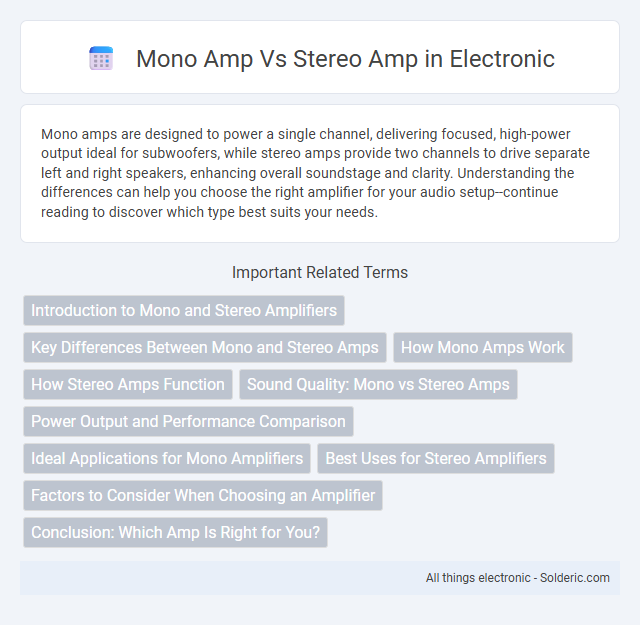Mono amps are designed to power a single channel, delivering focused, high-power output ideal for subwoofers, while stereo amps provide two channels to drive separate left and right speakers, enhancing overall soundstage and clarity. Understanding the differences can help you choose the right amplifier for your audio setup--continue reading to discover which type best suits your needs.
Comparison Table
| Feature | Mono Amplifier | Stereo Amplifier |
|---|---|---|
| Channels | Single channel | Two channels (Left & Right) |
| Usage | Subwoofers, single speaker setups | Full-range stereo speakers |
| Power Output | Higher power per channel | Split power across two channels |
| Sound Quality | Focused bass, no stereo imaging | Stereo sound with spatial effects |
| Cost | Generally less expensive for single output | Cost-effective for two channel output |
| Complexity | Simpler design | More complex circuitry |
| Installation | Easy for single speaker setup | Ideal for stereo speaker placement |
Introduction to Mono and Stereo Amplifiers
Mono amplifiers deliver a single channel of audio power optimized for driving subwoofers or individual speakers, offering higher power output per channel and improved bass performance. Stereo amplifiers provide two separate audio channels, ideal for driving left and right speakers to create a balanced and immersive soundstage in home theaters or car audio systems. Choosing between mono and stereo amps depends on the audio setup needs, speaker configuration, and desired sound quality.
Key Differences Between Mono and Stereo Amps
Mono amps deliver power to a single channel, providing focused and often higher wattage output ideal for subwoofers or specific speakers in a sound system. Stereo amps power two channels independently, allowing for left and right audio separation to create a balanced and immersive listening experience. The choice between mono and stereo amps depends on the audio setup's requirements, such as the need for mono-focused power or dual-channel sound distribution.
How Mono Amps Work
Mono amps, or monoblock amplifiers, amplify a single audio channel, delivering focused, high-powered sound output ideal for subwoofers or specific audio channels. These amps convert low-level audio signals into powerful outputs by using a single internal amplifier circuit dedicated to one channel, ensuring minimal distortion and maximum power efficiency. Your audio system benefits from enhanced clarity and dynamic range when using mono amps, especially in setups demanding high bass performance.
How Stereo Amps Function
Stereo amps separate audio signals into two distinct channels, delivering left and right sound outputs to create a fuller, more immersive listening experience. Each channel is independently amplified, preserving the spatial qualities of the original recording and enhancing soundstage depth. This dual-channel system allows stereo amps to reproduce directional audio cues more accurately compared to mono amps.
Sound Quality: Mono vs Stereo Amps
Mono amps deliver focused power to a single channel, often producing clearer, more precise sound ideal for subwoofers or high-output applications. Stereo amps provide two separate channels, offering balanced audio distribution and enhanced spatial sound for full-range speakers. Choosing between mono and stereo amps depends on speaker setup and desired audio fidelity.
Power Output and Performance Comparison
Mono amps deliver dedicated power to a single channel, providing higher power output and more efficient performance for individual speakers or subwoofers. Stereo amps distribute power across two channels, generally offering lower wattage per channel but enabling simultaneous stereo sound reproduction. For applications demanding maximum output and clarity in a single channel, mono amps outperform stereo amps in raw power and reliability.
Ideal Applications for Mono Amplifiers
Mono amplifiers excel in powering subwoofers due to their focused single-channel output, which delivers high current and low-frequency performance essential for deep bass reproduction. They are ideal for car audio systems and professional sound setups where dedicated bass amplification is critical. Their design maximizes power efficiency and reduces distortion, making them the preferred choice for driving large, low-impedance subwoofers.
Best Uses for Stereo Amplifiers
Stereo amplifiers excel in delivering rich, immersive sound by driving two separate channels for left and right audio output, making them ideal for home theater systems, music listening, and gaming setups. Your stereo system benefits from precise spatial audio representation, enhancing the overall auditory experience with clear instrument separation and vocal clarity. These amplifiers are best for environments where stereo imaging and balanced sound distribution are essential for enjoying music and multimedia content.
Factors to Consider When Choosing an Amplifier
Choosing between a mono amp and a stereo amp depends on factors such as the number of speakers, audio channel requirements, and desired sound quality. Mono amps provide higher power output per channel ideal for subwoofers and single speaker setups, while stereo amps efficiently power two channels for full-range speaker pairs. Consider impedance matching, total harmonic distortion, and system expansion flexibility when selecting an amplifier for optimal audio performance.
Conclusion: Which Amp Is Right for You?
Choosing between a mono amp and a stereo amp depends on your audio setup and performance needs. Mono amps excel in delivering high power to a single channel, ideal for subwoofers and focused sound reinforcement, while stereo amps efficiently power two channels for a balanced music experience. Your decision should align with whether you prioritize powerful bass output or a versatile, all-in-one solution for stereo speakers.
mono amp vs stereo amp Infographic

 solderic.com
solderic.com